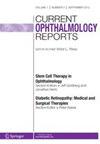Endophthalmitis risk factors associates with phacoemulsification (Literature review)
IF 0.8
Q4 OPHTHALMOLOGY
引用次数: 0
Abstract
The most frequent sources of microbial flora inside the eye are the ocular surface, foci of para-ocular infection of the patient. In vitreous samples from eyes with endophthalmitis microorganisms are revealed that are the saprophytic flora of the ocular surface. It is mainly represented by staphylococci, from which epidermal staphylococcus prevails quantitatively. Immunodeficiency states, diabetes mellitus, terminal liver and kidney diseases increase the risk of endophthalmitis development. Eradication of opportunistic pathogenic flora in the source loci, sanation of para-ocular infection, correction of somatic pathology by profile specialists is more relevant for endophthalmitis prevention. The problem of growing antibiotic resistance should also be considered. Thus, when selecting patients for surgery, one should be guided by the data on antibiotic resistance of the identified flora, pay attention to the presence of para-ocular infection and the systemic somatic status of the patient. This will provide a better vector for the development of recommendations for optimal prophylaxis.眼内炎与超声乳化术相关的危险因素(文献回顾)
眼内微生物菌群最常见的来源是患者的眼表、眼旁感染灶。在眼内炎的玻璃体样本中,发现了眼表面腐生菌群的微生物。主要以葡萄球菌为代表,其中表皮葡萄球菌在数量上占优势。免疫缺陷状态、糖尿病、晚期肝脏和肾脏疾病会增加眼内炎发展的风险。根除源位点的机会致病性菌群,眼旁感染的卫生,由侧写专家纠正躯体病理与预防眼内炎更相关。还应考虑到抗生素耐药性日益增长的问题。因此,在选择手术患者时,应以所鉴定菌群的抗生素耐药性数据为指导,注意是否存在眼旁感染和患者的全身躯体状态。这将为制定最佳预防建议提供更好的媒介。
本文章由计算机程序翻译,如有差异,请以英文原文为准。
求助全文
约1分钟内获得全文
求助全文
来源期刊

Current Ophthalmology Reports
Medicine-Ophthalmology
CiteScore
2.00
自引率
0.00%
发文量
22
期刊介绍:
This journal aims to offer expert review articles on the most significant recent developments in the field of ophthalmology. By providing clear, insightful, balanced contributions, the journal intends to serve those who diagnose, treat, manage, and prevent ocular conditions and diseases. We accomplish this aim by appointing international authorities to serve as Section Editors in key subject areas across the field. Section Editors select topics for which leading experts contribute comprehensive review articles that emphasize new developments and recently published papers of major importance, highlighted by annotated reference lists. An Editorial Board of more than 20 internationally diverse members reviews the annual table of contents, ensures that topics include emerging research, and suggests topics of special importance to their country/region. Topics covered may include age-related macular degeneration; diabetic retinopathy; dry eye syndrome; glaucoma; pediatric ophthalmology; ocular infections; refractive surgery; and stem cell therapy.
 求助内容:
求助内容: 应助结果提醒方式:
应助结果提醒方式:


